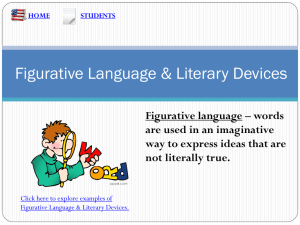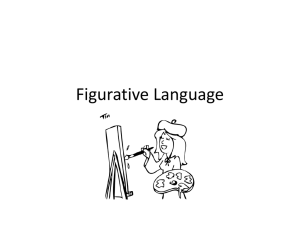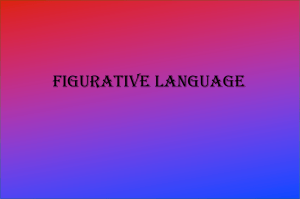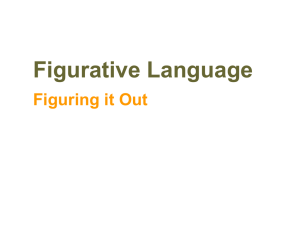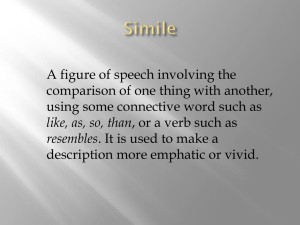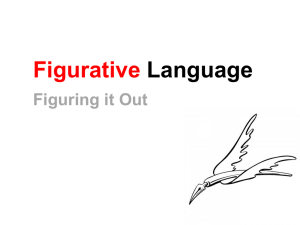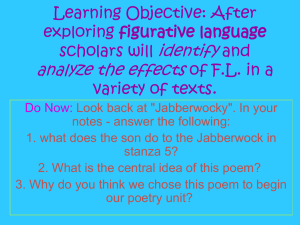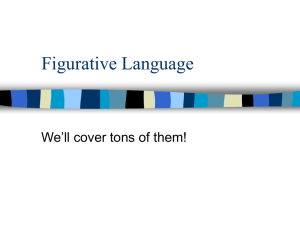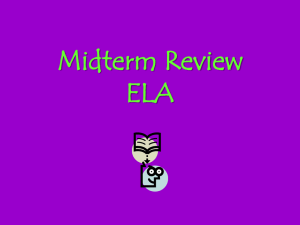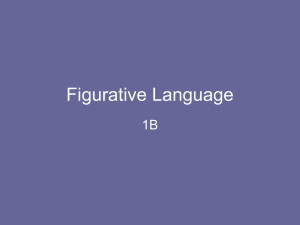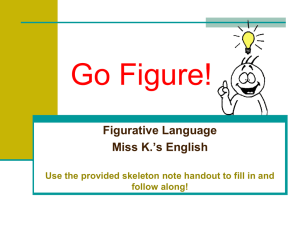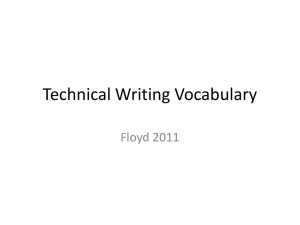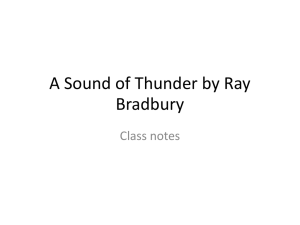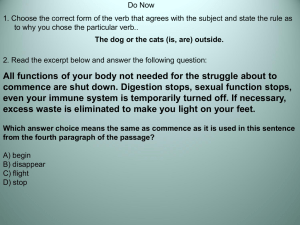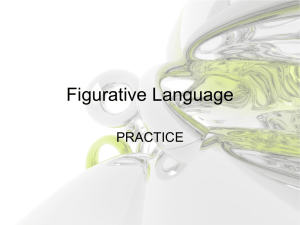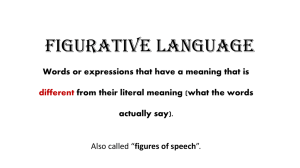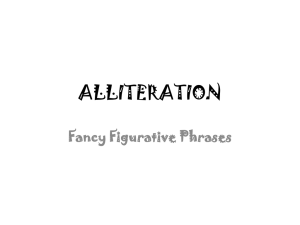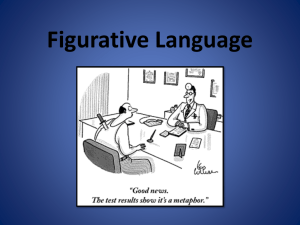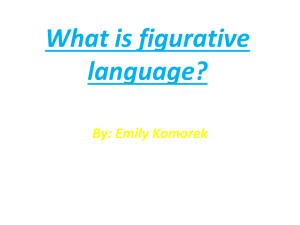Figurative Language
advertisement
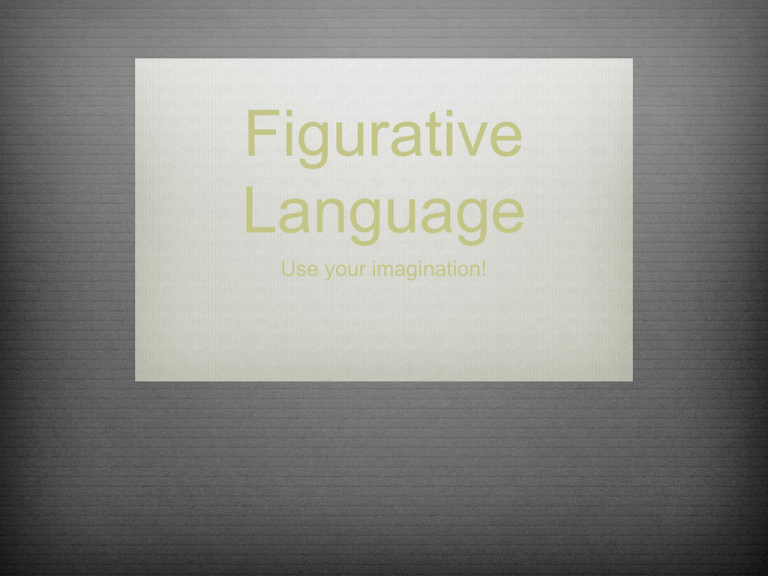
Figurative Language Use your imagination! Two types of Language Literal Language ● means exactly what it says. ● is explicit, obvious, out in the open and plainly stated. ● communicates an ideas clearly and plainly Figurative Language ● infers or suggests rather than stating directly. ● makes you use your imagination to figure out the author’s meaning ● helps a reader relate to what the author is trying to say. Types of Figurative Language ● Imagery ● Simile ● Metaphor ● Alliteration ● Personification ● Onomatopoeia ● Hyperbole Imagery ● Language that appeals to the senses. Descriptions of people or objects stated in terms of our senses. • Sight • Hearing • Touch • Taste • Smell Idioms ● An idiom or idiomatic expression refers to a construction or expression in one language that cannot be matched or directly translated wordfor-word in another language. Example: "She has a bee in her bonnet," meaning "she is obsessed," cannot be literally translated into another language word for word. Simile ● Definition: a comparison between two things we don’t usually think of as similar by connecting them with the words "like" or "as." ● Example: "The way you grow old is kind of like an onion or like rings inside a tree trunk." ["Eleven" by Sandra Cisneros] ● What is the author trying to say? ● How does this simile accomplish the author’s purpose? Simile WARNING Just because you see “like” or “as” does not mean you have found a simile! Ask yourself: What 2 unlike things are being compared? Not a simile: Sometimes you cry like you did when you were three. Simile: The red sweater is still sitting there like a big red mountain. Hyperbole ● ● Definition (pronounced: hi-PER-bow-lee): an extremely exaggerated description or statement that proves a point. Example: “Today I wish I was one hundred and two instead of eleven.” ["Eleven" by Sandra Cisneros] ● What is the author trying to say? ● How does using hyperbole accomplish the author’s purpose? ● What effect does this Figurative Language have on you as the reader? Hyperbole WARNING Hyperbole is EXTREME exaggeration to prove a point. Ask yourself: Is this an over the top exaggeration? Not hyperbole: I will never ride a roller coaster. Hyperbole: I could smell the pizza from a mile away Alliteration ● Definition: a group of words that start with the same consonant sound. ● Example: Sarah Sylvia Cynthia Stout would not take the garbage out. ● ● What is the author’s purpose for writing this way? How does alliteration accomplish the author’s purpose? Alliteration WARNING ● Alliteration is done on purpose. ● Pay attention to SOUNDS, not LETTERS ● Not alliteration: My dog is buried beside the tree. ● Alliteration: The frigid flakes fell softly on the frozen field Personification ● ● ● ● Definition: Giving human characteristics to nonhuman or inanimate objects (things that aren’t alive). Example: “But sometimes the prodigy in me became impatient. ‘If you don’t hurry up and get me out of here. I’m disappearing for good,’ it warned.” What is the author’s purpose for writing this way? How does alliteration accomplish the author’s purpose? Personification Personification in Advertising The toilet tissue that really cares for Downunder. (Bouquets toilet paper, Australia) What do you feed a machine with an appetite this big? (Indesit washing machine and Ariel Liquitabs, laundry detergent, UK) The car that cares (Kia cars) Kleenex says bless you. (Kleenex facial tissues) "Personification permits us to use knowledge about ourselves to comprehend other aspects of the world, such as time, death, natural forces, inanimate objects, etc." Allusion ● ● Definition: Making casual reference to a famous historical or literary figure or event, or to another work of literature that the author expects you to know. Example: “At first my mother thought I could be a Chinese Shirley Temple.” [“Two Kinds” by Amy Tan] ● What is the author trying to communicate? ● How does this allusion communicate that? Metaphor Definition: A direct comparison between two unlike things stating that one thing IS another. Example: “And after I played them both a few times, I realized they were two halves of the same song. “I was Cinderella stepping from her pumpkin carriage with sparkly cartoon music.” What is the author trying to say? How does this metaphor accomplish what the author is How does Figurative Language Affect a Text? ● Figurative Language Creates Mood ● Figurative Language Develops Characterization ● Figurative Language Advances the Plot ● Figurative Language Enhances Everyday Language Video of Effect ● https://learnzillion.com/lessons/4465-analyzeauthor-s-use-of-figurative-language
